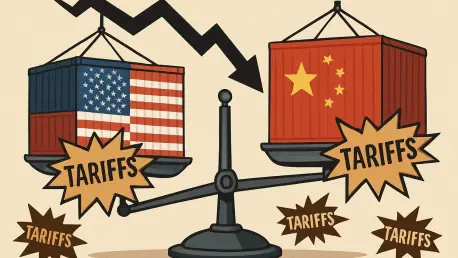In a world where global supply chains are already stretched thin, the latest trade skirmish between the United States and China has sent shockwaves through markets, with President Donald Trump announcing a staggering 100% tariff on Chinese imports effective November 1. This bold move, a direct response to China’s export controls on rare earth materials and critical technologies, underscores a deepening rift between the two economic powerhouses. The stakes couldn’t be higher as industries from technology to renewable energy brace for potential disruptions, making this a pivotal moment for investors and policymakers alike.
This market analysis aims to dissect the implications of these retaliatory measures, focusing on how tariffs and export restrictions are altering trade dynamics and affecting key sectors. By examining current trends, data, and projections, the goal is to provide clarity on how businesses and markets can navigate this turbulent landscape. The significance of rare earths, which are vital for high-tech manufacturing, positions this conflict as not just an economic issue, but a strategic battleground with far-reaching consequences.
Understanding the broader impact of these developments is essential for stakeholders across the globe. As both nations prioritize protective measures over cooperation, the ripple effects are felt in stock markets, commodity prices, and industrial output. This analysis will delve into the specifics of these policies, assess their market influence, and offer insights into future trajectories, equipping readers with the knowledge to adapt to an increasingly volatile economic environment.
Market Trends and Projections Under Trade Strain
Tariff Impact: A Blow to Import-Dependent Sectors
The imposition of a 100% tariff on Chinese imports by the U.S. marks a significant escalation in trade barriers, directly affecting industries reliant on affordable goods from China. Sectors such as consumer electronics, automotive manufacturing, and retail are poised to face higher input costs, which could translate into elevated prices for end consumers. Market data suggests that companies with heavy exposure to Chinese supply chains may see profit margins shrink by up to 15% if alternative sourcing isn’t secured swiftly, a challenge given the scale of China’s manufacturing dominance.
Beyond immediate cost pressures, these tariffs are likely to disrupt long-standing trade patterns, pushing firms to explore nearshoring or diversifying suppliers to regions like Southeast Asia or Latin America. However, such transitions are neither quick nor inexpensive—analysts project a timeline of 2-3 years to establish robust alternative networks. In the interim, market volatility is expected to rise, with indices tracking manufacturing and import sectors showing early signs of investor caution as uncertainty looms over sustained profitability.
The broader projection here is a potential slowdown in U.S. economic growth if consumer spending weakens under price hikes. While the tariffs aim to protect domestic industries, historical patterns indicate mixed outcomes—some sectors may benefit from reduced foreign competition, but others could struggle with supply shortages. Monitoring quarterly earnings reports from major corporations in the coming months will be crucial to gauge the real-time impact of these measures on market confidence.
Rare Earth Restrictions: A Chokehold on Tech and Energy Markets
China’s decision to impose export controls on rare earth materials, lithium batteries, and graphite anode components, effective November 8, has rattled markets dependent on these critical resources. With China controlling over 80% of global rare earth production, this move threatens to create bottlenecks for industries like electric vehicle manufacturing, renewable energy systems, and defense technology. Early market reactions have seen a spike in futures prices for rare earth elements by nearly 20% since the announcement, reflecting fears of supply scarcity.
The strategic leverage of these restrictions cannot be overstated—rare earths are integral to producing magnets for wind turbines and components for smartphones, making them indispensable to modern economies. Projections indicate that without rapid diversification, global tech output could face a production shortfall of 10-15% over the next year, particularly impacting firms in Europe and North America that lack immediate alternatives. Efforts to ramp up mining in countries like Australia or Canada are underway, but scaling to meet demand could take until at least 2027, leaving markets vulnerable in the near term.
Investors are already pivoting toward companies involved in rare earth recycling and synthetic alternatives, though these technologies are not yet at commercial scale. Market sentiment suggests a growing interest in firms innovating in this space, with venture capital inflows into resource diversification startups increasing by 30% in recent quarters. The challenge lies in balancing short-term supply risks with long-term sustainability goals, a dynamic that will shape commodity markets and industrial strategies moving forward.
Global Ripple Effects: Beyond Bilateral Trade Woes
The U.S.-China trade conflict extends its influence far beyond their borders, disrupting global markets and creating uncertainty for regional economies. European nations, heavily reliant on Chinese rare earths for their green energy transitions, face potential delays in meeting carbon reduction targets as supply chains tighten. Market forecasts predict a 5-8% cost increase for renewable energy projects in the region, which could dampen investment enthusiasm and slow progress toward sustainability goals.
Emerging markets, often caught in the crossfire of such disputes, are also feeling the strain as prices for essential technologies rise. Countries in Africa and South Asia, which depend on affordable electronics and battery components for development, may see project timelines extend or costs balloon, hampering economic growth. Commodity markets are reflecting this tension, with lithium and graphite prices trending upward, signaling broader inflationary pressures that could persist if diplomatic resolutions remain elusive.
Looking ahead, the trend toward economic fragmentation appears set to intensify, with nations and corporations alike prioritizing self-reliance over global integration. Trade data indicates a 10% uptick in regional trade agreements as countries seek to insulate themselves from superpower conflicts. While this may offer some stability, it also risks creating a patchwork of isolated markets, reducing overall efficiency and innovation—a scenario that investors must factor into long-term portfolio strategies.
Reflections and Strategic Pathways Forward
Looking back, the escalation of trade tensions through tariffs and rare earth export controls marked a critical juncture in global market dynamics. The actions taken by the U.S. and China revealed deep-seated strategic priorities, overshadowing earlier attempts at negotiation and truce. The immediate fallout saw heightened volatility across sectors, with technology and energy markets bearing the brunt of supply chain uncertainties.
For businesses, the path forward involves urgent diversification of supply sources, with a focus on tapping into non-Chinese rare earth reserves or accelerating recycling initiatives. Policymakers need to consider incentives for domestic production and forge international alliances to secure critical materials. Investors, meanwhile, must recalibrate risk assessments, seeking opportunities in firms pioneering alternative technologies while bracing for short-term market fluctuations.
Ultimately, navigating this landscape demands a proactive stance—stakeholders must prioritize resilience through innovation and collaboration. Exploring third-party mediation or regional partnerships offers a potential buffer against ongoing bilateral friction. As markets adapt, the lessons from this period underscore the need for agility and foresight in an era where trade policies can swiftly reshape economic realities.









